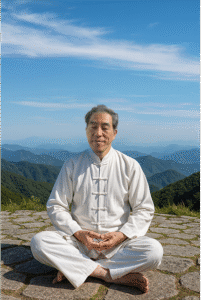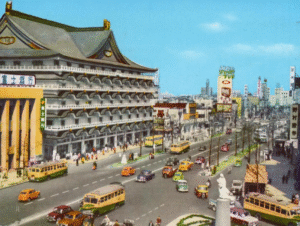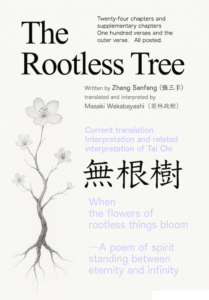About Me
Masaki Wakabayashi

In the philosophy of the Dao, Wu Ji (the Limitless) is that which contains all things, yet is itself devoid of all things. From Wu Ji arises Yin and Yang, forming Tai Ji (the Great Ultimate), which in turn gives birth to the Four Symbols, the Eight Trigrams, and all phenomena of existence.
Xieyi painting is an art that expresses this unfolding of manifestation from Wu Ji through brush and ink—it is both a talisman and, within spatial context, a form of feng shui.
I studied xieyi painting as a symbolic art (fu-tu) under a Daoist master from Wudang Mountain, China, learning it alongside the philosophical interpretation of the Rootless Tree (Wugen Shu). I have now completed a series of artworks corresponding to each verse and line of the poems. These paintings express not only the heart of the poetry, but also the unseen elements—qi, rhythm, flow, stillness, and space. It is my hope that these works serve as talismanic art, much like the ancient principles of Chinese feng shui—transmitting and harmonizing qi throughout a space, and sending quiet ripples into the hearts of those who view them. Moving forward, I will continue to create xieyi works inspired by poetry and narrative, reimagined for the present age.

Born in Osaka in 1957. His maternal grandmother was a female *Rōkyoku* performer named Koushiwaka, and his grandfather was a senior figure (second-in-command) in a bakuto syndicate that managed entertainment enterprises.In addition, he received guidance from a signboard painter of Osaka Shin-Kabukiza from a young age and learned the basics of Xieyi painting.
From an early age, he received professional training in wrestling, swordsmanship, and performing arts at the dojo of the All Japan Pro-Wrestling Association and the Kabukiza Theater, both operated by his grandfather’s syndicate. He also received instruction in painting from the head billboard artist of the Osaka Kabukiza Theater.
During high school, he studied the Yagyū Shinkage-ryū school of swordsmanship. In adulthood, he began private and intensive training under a Wudang Tai Chi master—formerly a bodyguard to his grandfather—who passed on teachings in Tai Chi, internal cultivation (Tai Chi Gong), Daoist philosophy such as Laozi and The Rootless Tree, Chinese expressive painting (xieyi), and evidential scholarship (kaozheng). At around the age of 30, he received formal certification in these arts. From that point, he began creating xieyi paintings inspired by the philosophy of The Rootless Tree, as a method of deepening his understanding.
 In his twenties, he served as CEO of an advertising and planning company. In 1988, he introduced the “Panda Goldfish,” which he had obtained in Hong Kong, to Japan. He gained wide media attention through appearances on TV, newspapers, and magazines, and relocated to Tokyo to expand the business, later working on business development projects for major corporations.
In his twenties, he served as CEO of an advertising and planning company. In 1988, he introduced the “Panda Goldfish,” which he had obtained in Hong Kong, to Japan. He gained wide media attention through appearances on TV, newspapers, and magazines, and relocated to Tokyo to expand the business, later working on business development projects for major corporations.
After moving to Yokohama, he founded and managed a nationwide consumer organization for housewives. Since his thirties, he has consistently researched the theories of Tai Chi, promoted its health and martial aspects, and conducted classes in Tai Chi and Qigong.
In 2025, after nearly four decades of dedicated study, he completed the full interpretation of The Rootless Tree’s 24 chapters and 100 verses, along with over 250 xieyi paintings depicting each chapter and verse as symbolic diagrams (fu tu). He became the first in Japan to publish a complete commentary on The Rootless Tree and to present its visual representation through art.
He continues to publish works on Eastern philosophy, Chinese medicine, Tai Chi Gong, Qigong, and Daoist poetic art, releasing new xieyi concept artworks centered on philosophical verse.
Publications include:
– Refining the Body to the Bone through Simplified 24-Form Tai Chi
– The World’s Most Beautiful Simplified 24-Form Tai Chi
– True History of Tai Chi (3 volumes: Upper, Middle, Lower)
– Tai Chi vs. COVID-19
– Dialogue Between Laozi and a Housewife (Dao & De Volumes)
– Yang Style 85-Form Tai Chi,/The Rootless Tree/24Chapters/100Verse among others
Copyright © MASAKI WAKABAYASHI. All rights reserved.

